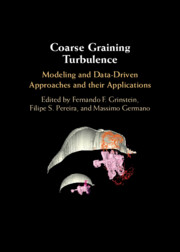Book contents
- Frontmatter
- Contents
- Contributors
- Prologue
- Part I Paradigms and Tools
- 1 Numerical Simulations and Coarse-Graining
- 2 An Overview of Scale-Resolving Simulation Models for Practical Flows
- 3 Filtering Approaches and Coarse Graining
- 4 Filtered Density Function
- 5 Symmetries, Subgrid-Scale Modeling, and Coarse Graining
- 6 Coarse-Graining Turbulence Using the Mori–Zwanzig Formalism
- 7 Data-Driven Modeling for Coarse Graining
- 8 Verification, Validation, Uncertainty Quantification, and Coarse-Graining
- Part II Challenges
- Epilogue
- Abbreviations
- Index
- References
8 - Verification, Validation, Uncertainty Quantification, and Coarse-Graining
from Part I - Paradigms and Tools
Published online by Cambridge University Press: 31 January 2025
- Frontmatter
- Contents
- Contributors
- Prologue
- Part I Paradigms and Tools
- 1 Numerical Simulations and Coarse-Graining
- 2 An Overview of Scale-Resolving Simulation Models for Practical Flows
- 3 Filtering Approaches and Coarse Graining
- 4 Filtered Density Function
- 5 Symmetries, Subgrid-Scale Modeling, and Coarse Graining
- 6 Coarse-Graining Turbulence Using the Mori–Zwanzig Formalism
- 7 Data-Driven Modeling for Coarse Graining
- 8 Verification, Validation, Uncertainty Quantification, and Coarse-Graining
- Part II Challenges
- Epilogue
- Abbreviations
- Index
- References
Summary
Quantifying and assessing the computational accuracy of coarse-graining simulations of turbulence is challenging and imperative to achieve prediction – computations and results with a quantified and adequate degree of uncertainty that can be confidently used in projects without reference data. Verification, validation, and uncertainty quantification (VVUQ) provide the tools and metrics to accomplish such an objective. This chapter reviews these methods and illustrates their importance to coarse-graining models. Toward this end, we first describe the sources of computational errors and uncertainties in coarse-graining simulations of turbulence, followed by the concepts of VVUQ. Next, we utilize the modified equation analysis and the physical interpretation of a complex problem to demonstrate the role of VVUQ in evaluating and enhancing the fidelity and confidence in numerical simulations. This is crucial to achieving predictive rather than postdictive simulations.
- Type
- Chapter
- Information
- Coarse Graining TurbulenceModeling and Data-Driven Approaches and their Applications, pp. 222 - 260Publisher: Cambridge University PressPrint publication year: 2025

